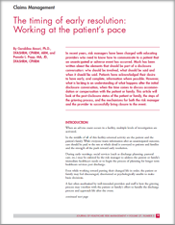Resource:
Timing of Early Resolution: Working at the Patient's Pace
Post-disclosure status, the steps of the grieving process, the mechanisms for both the risk manager and the provider to successfully bring closure
In recent years, risk managers have been charged with educating providers who need to know how to communicate to a patient that an unanticipated or adverse event has occurred. Much has been written about the elements that should be part of a disclosure conversation: who should be involved, what should be said and when it should be said. Patients have acknowledged their desire to have early, and complete, information where possible. However, what is lacking is an understanding of what happens after the initial disclosure conversation, when the time comes to discuss accommodation or compensation with the patient or family. This article will look at the post-disclosure status of the patient or family, the steps of the grieving process, and the mechanisms for both the risk manager and the provider to successfully bring closure to the event.
INTRODUCTION
When an adverse event occurs in a facility, multiple levels of investigation are activated. In the middle of all of this facility-oriented activity are the patient and the patient’s family. While everyone wants information after an unanticipated outcome, care should be paid to the rate at which detail is conveyed to patients and families and the strength of the push toward early resolution.
During early meetings, social services (such as discharge planning, pastoral care, etc.) may be enlisted by the risk manager to address the patient or family’s immediate health care needs or to begin the process of planning for longer term health care services post discharge. Even while working toward putting their changed life in order, the patient or family may feel discouraged, disoriented or psychologically unable to make basic decisions.
A fact often overlooked by well-intended providers and staff is how the grieving process may interfere with the patient or family’s effort to handle the discharge process and approach life after the event. Risk management personnel want to do the right thing in initiating early resolution by assuming responsibility for harm caused by the care provided (as well as hoping to possibly mitigate liability exposure). They may want to discuss financial matters with the patient and/or family but feel uncomfortable having these conversations before the patient’s discharge. Meetings are scheduled, and discussions anticipated.
Nevertheless, the grieving process may render the patient or family incapable of having a conversation about the event’s cause, or of comprehending any accommodations or compensation offered. Placing a dollar value on a death or injury is a difficult burden for many patients and families, especially when asked to do so immediately following a funeral or while adjusting to a life-altering injury.
So, when is a good time to approach a patient or family for a pre-litigation resolution? There is no easy answer, other than to recognize that it can only be determined on a case-bycase basis and when the key parties are ready to do so, which may not occur until they begin to experience the emotional stage of acceptance.
Download the full article to learn more.

